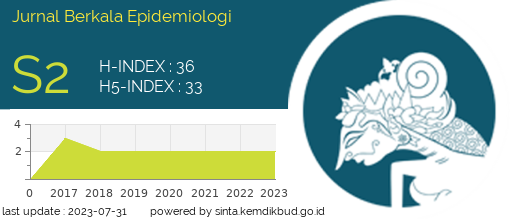THE IMPACT OF ACNE VULGARIS ON THE QUALITY OF LIFE IN TEEN PATIENTS
Downloads
Background: Acne vulgaris (AV) is one of the most common cutaneous diseases in teenagers, which causes a decrease in self-esteem. Low self-esteem can affect the quality of life in AV patients. Purpose: This research aims to analyze the impact of AV on the quality of life in teenage patients based on their age, education level, and AV severity. Methods: This research used a non-probability purposive sampling technique and an observational analytic method with a cross-sectional design. The research location was SMPN 18 and SMAN 3 Surabaya. This study was conducted from August 2019 until January 2020. The samples were 109 teenagers; the total population was 2,121 teenagers. Research variables are AV severity and AV patients' quality of life. Research instruments were Lehmann's Grading System for evaluating AV severity and Dermatology Life Quality Index (DLQI) in teenage AV patients. Data obtained was analyzed with the fisher-exact test method. Results: There were 46 (42.20%) males and 63 (57.80%) females in this study. DLQI results showed that AV had an enormous impact on quality of life in 12.80% of cases among all subjects. AV has a great potential to precipitate anxiety and affect the quality of life without considering the severity of the disease. Correlation between quality of life and age; quality of life and education level; quality of life and AV severity level resulted in p values of 0.19; 0.08; and 0.59. Conclusion: The management of AV in teenage patients should consist of individual treatment, education about AV, and its impact on the quality of life, as one of the critical social determinants of health.
References
S. Kang et al., Fitzpatrick Dermatology in General Medicine, 9th ed. New York: Mc Graw Hill, 2019.
D. D. Lynn, T. Umari, C. A. Dunnick, and R. P. Dellavalle, "The epidemiology of acne vulgaris in late adolescence,” Adolesc. Health. Med. Ther., vol. 7, pp. 13–25, 2016, doi: 10.2147/ahmt.s55832.
F. F. Alshammrie, R. Alshammari, R. Alshammari, F. H. Khan, and F. H. Khan, "Epidemiology of Acne Vulgaris and Its Association With Lifestyle Among Adolescents and Young Adults in Hail, Kingdom of Saudi Arabia: A Community-Based Study,” Cureus, 2020, doi: 10.7759/cureus.9277.
T. Ch. Muhammad, "Pathogenesis of acne vulgaris: Simplified,” J. Pakistan Assoc. Dermatologists, vol. 20, no. 2, pp. 93–97, 2010, [Online]. Available: https://www.jpad.com.pk/index.php/jpad/article/view/398.
M. Saeed Alanazi, S. Mohamed Hammad, and A. Elwan Mohamed, "Prevalence and psychological impact of Acne vulgaris among female secondary school students in Arar city, Saudi Arabia, in 2018,” Electron. Physician, vol. 10, no. 8, pp. 7224–7229, 2018, doi: 10.19082/7224.
E. Okoro, A. Ogunbiyi, and A. George, "Prevalence and pattern of acne vulgaris among adolescents in Ibadan, south-west Nigeria,” J. Egypt. Women's Dermatologic Soc., vol. 13, no. 1, pp. 7–12, 2016, doi: 10.1097/01.EWX.0000470561.85599.0d.
G. N. Vilar, "Quality of life, self-esteem and psychosocial factors in adolescents with acne vulgaris,” An Bras Dermatol, vol. 90, no. 5, pp. 622–629, 2015, doi: 10.1590/abd1806-4841.201533726.
E. Mallon, J. N. Newton, A. Klassen, S. L. Stewart-Brown, T. J. Ryan, and A. Y. Finlay, "The quality of life in acne: A comparison with general medical conditions using generic questionnaires,” Br. J. Dermatol., vol. 140, no. 4, pp. 672–676, 1999, doi: 10.1046/j.1365-2133.1999.02768.x.
PERDOSKI, Panduan Praktik Klinis Bagi Dokter Spesialis Kulit Dan Kelamin Di Indonesia. Jakarta: PP PERDOSKI, 2017.
S. M. Wasitaatmadja, Kelompok Studi Kelompok Studi Dermatologi Kosmetik Indonesia : AKNE. Jakarta: Badan Penerbit FKUI, 2018.
E. Tasoula et al., "O impacto da acne vulgar na qualidade de vida e saúde psíquica em jovens adolescentes na grécia. resultados de uma pesquisa populacional,” An. Bras. Dermatol., vol. 87, no. 6, pp. 862–869, 2012, doi: 10.1590/S0365-05962012000600007.
M. S. Lewis-Jones and A. Y. Finlay, "The Children's Dermatology Life Quality Index (CDLQI): Initial validation and practical use,” Br. J. Dermatol., vol. 132, no. 6, pp. 942–949, 1995, doi: 10.1111/j.1365-2133.1995.tb16953.x.
A. Y. FINLAY and G. K. KHAN, "Dermatology Life Quality Index (DLQI)”a simple practical measure for routine clinical use,” Clin. Exp. Dermatol., vol. 19, no. 3, pp. 210–216, 1994, doi: 10.1111/j.1365-2230.1994.tb01167.x.
S. Sivaramakrishnan and T. Jayakar, "A study on the dermatology life quality index in patients with acne vulgaris,” Int. J. Res. Dermatology, vol. 5, no. 4, p. 774, 2019, doi: 10.18203/issn.2455-4529.intjresdermatol20194667.
- Every manuscript submitted to must observe the policy and terms set by the Jurnal Berkala Epidemiologi
- Publication rights to manuscript content published by the Jurnal Berkala Epidemiologi is owned by the journal with the consent and approval of the author(s) concerned. (download copyright agreement)
- Complete texts of electronically published manuscripts can be accessed free of charge if used for educational and research purposes according to copyright regulations.

JBE by Universitas Airlangga is licensed under a Creative Commons Attribution-ShareAlike 4.0 International License.























